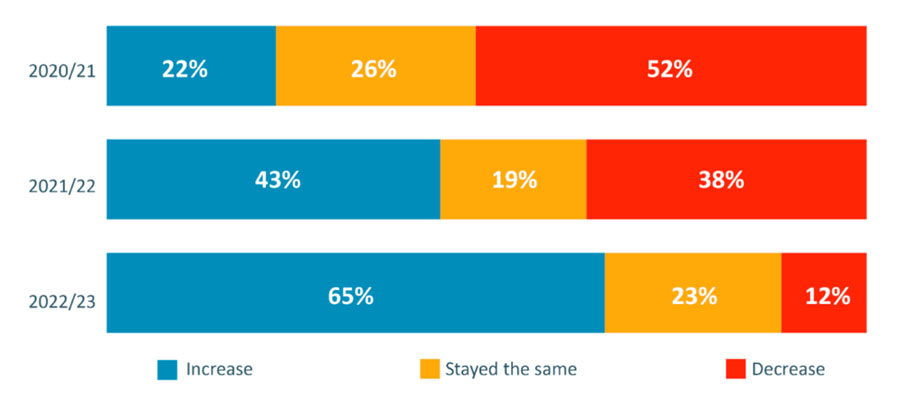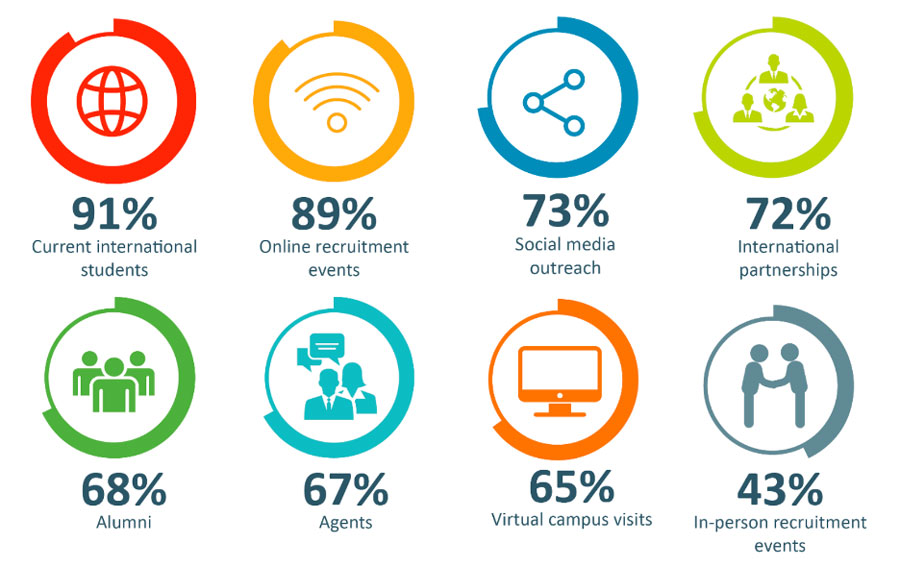
International Education News
Most US colleges report increasing numbers of international student applications for 2022/23
Most US colleges report increasing numbers of international student applications for 2022/23
Short on time? Here are the highlights:
- 65% of US colleges responding to an IIE Spring 2022 Snapshot Survey report that they are receiving more international student applications for the coming academic year than in 2020 or 2021
- More than 9 in 10 are committed to hosting international students in-person, on campus
- Over two-thirds are working with agents in their recruitment activities and agents are viewed as the most helpful of channels/strategies, along with online events, leveraging the power of current international students, and international partnerships
The Institute of International Education (IIE) has released its Spring 2022 Snapshot on International Educational Exchange, based on a survey conducted in April of 559 US higher education (HE) institutions. A majority of the institutions are seeing increased applications from international student compared to a year ago, and virtually all of them are committed to offering on-campus, in-person instruction to international students.
The surveyed institutions were a mix of public and private and spanned all categories of degree-granting colleges, from the associate to the doctoral level.
Most colleges report an increase
After suffering steep losses in new international student enrolments in 2020 and 2021, US colleges are on track for recovery given a surge in applications for degree studies in 2022/23. Two-thirds (65%) said applications have increased, compared with 43% last year and 22% in 2020/21. Only 12% said that international students have submitted fewer applications for the 2022/23 academic year.
 More than 6 in 10 surveyed US colleges and universities are receiving more international student applications for the 2022/23 academic year. Source: IIE
More than 6 in 10 surveyed US colleges and universities are receiving more international student applications for the 2022/23 academic year. Source: IIE
Demand is particularly high for master’s and doctoral-level degrees. Roughly three-quarters of master’s colleges and universities (76%) and doctoral universities (73%) reported a rise in the number of applications from international students.
Institutions are working hard to recover their international enrolments, committing to recruitment and admissions practices they might not have used to any great degree prior to COVID-19. For example:
- 84% allow for the online submission of applications
- 54% are permitting students to send in online test results rather than in-person scores
- 28% have extended application deadlines
- 25% are giving students more time to accept an offer of admission
- 43% are recruiting international students in-person
Many are working with agents
More than two-thirds of institutions are working with agents to help them achieve their international recruitment goals for 2022/23.
The IIE survey report notes,
“We asked what outreach and recruitment tools were the most useful for institutions. When considering this, reporting institutions most readily cited agents, online recruitment events, current international students, and international partnerships as the recruitment tools with the highest utility.”
 Top resources used by US colleges and universities to recruit international students for the 2022/23 academic year. Source: IIE
Top resources used by US colleges and universities to recruit international students for the 2022/23 academic year. Source: IIE
Main mode of instruction is now in-person
More than half (55%) of the HE institutions surveyed reported that this spring, all their students (domestic and international) were studying in-person, compared with only 8% a year ago. At the same time, the hybrid mode of delivery that gathered steam in the pandemic is here to stay. A minority of institutions did not offer hybrid course delivery before the pandemic, and most of those intend to provide online options going forward. Only 7% of HE institutions do not intend to offer virtual instruction in the future.
 Comparing planned instruction modes of US colleges and universities in 2021 and 2022. Source: IIE
Comparing planned instruction modes of US colleges and universities in 2021 and 2022. Source: IIE
While most institutions will offer some courses online or through a hybrid model, the focus now is on bringing international students into the US to receive in-person instruction on campus. The survey revealed less investment in providing advising services and/or accommodations to international students studying online.
Almost all (96%) of institutions plan to offer in-person study in fall 2022, while only 66% will allow students to defer to spring 2023 if they cannot travel at that time – down from 77% who made that accommodation last year. Only around one-third will provide online enrolment to international students until they can come to campus.

“What will your institution offer to international students enrolled in fall 2022?” Source: IIE
In the fall, 61% of institutions intend to offer hybrid instruction and 33% will be delivering classes in-person only.
Total higher education enrolments are declining
This year’s positive news for international student numbers contrasts with a longer-term downward pattern of declining college enrolments in the US which was underway before the pandemic started. That trend is continuing this year according to the National Student Clearinghouse Research Center semesterly report, which notes that total HE enrolments (counting both domestic and international students) were down by 4.1% in spring 2022 compared to spring 2021. Over the past two years, enrolments have fallen by 9.4% overall, which is equivalent to a loss of 1.4 million students across the US college system.
The pandemic appears to have accelerated the trend of US students opting out of degree studies. The Chronicle of Higher Education reports that “not even half of 2020 high-school graduates are pursuing higher education,” an ominous sign for the US economy given that research shows students who do not go straight from high school to college are less likely than other students to earn a degree in their lifetime.
A survey of more than 1,000 high-school students conducted last year by ECMC Group found that the likelihood of students enrolling in a four-year university fell nearly 20% over eight months in 2020 and 2021. ECMC had polled the students three times in that time span. The first survey found that 71% of students planned go on to four-year degree studies. By the third survey, only 53% were intending to. According to University World News, the report found that,
“High schoolers are putting more emphasis on career training and post-college employment. More than half said they can achieve professional success with three years or less of college, and just one-fourth believe a four-year degree is the only route to a good job.”
High tuition fees for degree studies are at the root of the trend. It now costs students more than USD$50,000 per year for tuition and accommodation at private four-year colleges, and more than USD$20,000 per year at public, in-state colleges. University World News puts these fees in context: “The significant increase in the cost of college has outpaced both inflation and – even more starkly – family income over recent decades.”
The cost of tuition in the US is also often significantly higher than tuition for comparable degrees in other major study destinations – and this is not going unnoticed by price-sensitive international students. Canada, the United Kingdom, Germany, and the Netherlands have recovered international enrolments lost in the pandemic more quickly than the US.
Scholarship provision is on the rise
A significant proportion of US colleges are offering more scholarships to entice talented students to choose them over other options – including online options. According to the QS Admissions Survey conducted in March and April 2022, one-third (32%) of North American business schools are now offering more scholarships to MBA applicants, and more than half of those are offering “significantly” more. In comparison, 25% of European business schools said they were offering more scholarships and only 3% said they were providing “significantly” more.
Richard Castleberry, director of MBA programmes at Mays Business School at Texas A&M University, told QS that competition for MBA students is particularly fierce because so many students are enrolling in online MBAs:
“Ten years ago or even five years ago, online study was viewed very differently but now it has really grown in acceptance. Now, there are schools whose online programmes are bringing in a large number of students, which is having an effect on recruitment to on-campus programmes.”
As we reported recently, US educators enrolled more students in online MBAs than in MBAs delivered in person in 2021.
 American University Staff to Go on Strike if Negotiations Fail
American University Staff to Go on Strike if Negotiations Fail
International Education News|2022-08-17
MORE